Scott Berkun's Blog, page 3
February 10, 2021
How Design Makes The World: Typos and corrections?
Did you read How Design Makes the World? Thanks. I’m glad you did.
If you found any any typos or mistakes along the way, I apologize. But I’m asking you to report them here so they can be corrected in a future edition.
The first edition of the book has 130+ footnotes, 60+ recommendations and dozens of properly attributed photo and media credits. I work hard to get it right, but alas mistakes do happen.
Please leave a comment, and a page # if possible. Much appreciated.
Here are the known issues:
Print editionpg 41, Hundertwasser was Austrian, not German 154 – 5th line from the bottom, “People hate traffic when that are in it…” – should be they Pg. 188, Maurice Sy -> Marice Sy Kindle / Digitalpg. 50 / Chapter 7 – fonts missing (Kindle only)February 9, 2021
UX Design: The most difficult concepts to explain (list)
Last week I asked on twitter which concepts were hardest for UX designers to explain to their teams. As promised here are the responses with some commentary.
The big risk in looking at lists like this is it’s easy to fall into the trap of blaming other for what are our limitations. This violates our own advice:

It’s true that some people we work with should have learned these by now, but it’s wise to err on the side of improving how we teach rather than blaming the students.
Which makes Christian Crumlish’s comment perhaps the most valuable:
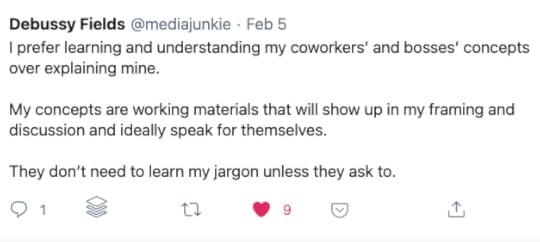 The list of difficult concepts
The list of difficult conceptsThese were the three most common responses:
You are not the user (#). The difference between UI & UX. It’s not just what it looks like… it’s how it works too. Perception is often that UX is just a lick of paint (#).Here is the rest of the list (I trimmed duplicates):
Some of the most important UX research that’s conducted has nothing to do with deciding where to put a button (#).Designers learn through the act of making (#).Doing research up front will not slow you down, but will save you time (#).That vision work and deep thinking through longer term complexity takes time and that time trades off against filling the timeline with reactive/nearterm work (#).For me, it’s that there’s a difference between knowing the space and knowing how users experience the space(#).That we can’t make the currently being worked on feature the most discoverable. No matter what you’re currently working on, it has to be in the context of the overall journey(#).Not everything is a visual deliverable(#).Looks good ≠ is good (#)That I am not the source of ideas. That I can’t work in a vacuum and produce user experiences. That UX is not a single input at the start of a pipeline of work, or a checkbox on a project list (UX is a process, not a deliverable)(#).That we dont have all the answers. Our job is to help uncover the answers (#).Design coherence. A solution is not simply a collection of features or functions, it is the way they fit together in a sensible, useful way. Adding or removing an element may be easy to do gracefully, or very hard, depending on the overall design (#).That a single change often has cascading consequences — that parts are (or should be) always related to the whole (#).UX vs. UX Theater (#).If you aren’t designing the right thing, you can’t design the thing right (#).You must define functionality before implementation. And probably draw a map in between (#).Pretty and efficient aren’t mutually exclusive, but pretty ≠ efficient (#).In the case of software especially, we have to consider not only how it feels to do a task once, but how it feels to do that same task ten times a day, every day (#).The “user experience” is not owned by a company, but by people. It’s actually people trying to live, tackling their problems or striving for their aspirations. Their experience is bigger than any single touchpoint or brand (#).The complexity has to live somewhere. You can’t make something powerful and infinitely flexible for power users ALSO be intuitive and simple for beginners (#). That a feature is not a user goal (#).That I usually should not (and often can not) provide off-the-cuff design advice without understanding the context of a product/feature/service (#).Reminding people that we have to avoid shipping the org chart (#).The user experience doesn’t start and end at the confines of a screen (#).Defining the problem and the outcomes is key – the same design can be done 10 different ways but each of those 10 options are solving for different problems and lead to different outcomes (#).Reframing. The thing they think they want turns-out not to be the best opportunity, but once they have that thing in their mind, it’s impossible to convince them it won’t work (even if something else will work better) (#)That UX is not just doing what customers want but that it is the process of understanding what customers need and combining with the business goals to deliver best experience (#).Research is (MUCH) more than usability testing (#).The easier it looks, the more work it took to get there (#).Metric tradeoffs: why sometimes it’s worth it to take a short term hit in a key metric in exchange for an overall experience improvement that harder to quantify (#).The fact that designers and everyone who intervenes in perception have an ethic responsibility to those humans first, not to the business. As designers we have a responsibility to be congruent & empathic and to hold the people we design for in unconditional, positive regard.(#). Even the best UX design can’t fix messed up organizational structure or people problems (#).The difference between strategic work (decision-making) and tactical work (hands-on crafting), and how designers must be good at both (#).That UX debt (the many small decisions that lead to inconsistencies and bad behaviors) will cause major negative consequences both for internal teams and customers down the road. It’s worth it to put in more effort to avoid it even if it takes more time (#).The fact that ‘It depends’. Context has a huge influence on what could be the best solution to a problem, but my experience has been that often people expect the UX designer to have answers based on abstract rules instead. Yes: there are best practices, but still … it depends (#).Progressive Disclosure – a design should only be as complex as they are ready for at the time (#)Have one that isn’t listed? Or a great way to explain one of these? Leave a comment.
February 3, 2021
How To Put Faith in Design
Anglerfish are famous for the glowing lure they dangle from their heads that they use to catch small fish. But this is not the most interesting thing about them. Their most fascinating trait is how they mate. Males of the species, who are much smaller, lack a functioning digestive system. To survive they must combine, or fuse-mate, with the females. This means they bite into the female’s skin, releasing an enzyme that bonds them together for life. In exchange for the nutrients they need to live, they provide her with sperm. If this sounds desperate that’s because it is: only 1% of males live long enough to find a mate.

If the equivalent of the shiny lure atop the anglerfish were part of a tech product, deceiving people into making bad choices, we’d call it a dark pattern: a deliberate deception that causes harm to one party but benefits the other. But we don’t use this label to apply to nature because… well I’m not sure why. Evolution is about good design for survival and we can learn from its history, even if we don’t agree with its morality. But the history of design most UX designers know starts with the Macintosh. We have a narrow view of how design fits into the world, even into the world of business, and that works against us.
Corporations, like anglerfish and other living things, are designed to survive. They evolve and use tactics that manipulate perception. Consider how the tail of a male peacock is a kind of advertising. Or how that ultraviolet light in orchid petals, crafted to attract insects for fertilization, is part of its “plant marketing strategy.” There’s perhaps nothing wrong with trying to get others interested in what you have to offer. It seems fair and natural, doesn’t it?
Yet there is also the Cuckoo bird. It lays an egg in other bird species’ nests without the mother knowing. When the young cuckoo hatches, it pushes its unhatched step-siblings out of the nest to fall to their death. It’s a killer baby bird! We’d call this immoral, or homicidal, if humans did it, but we struggle to rationalize our morality with the natural world we’ve evolved from and are still a part of.
Founders, as a kind of creature to stay with the metaphor, don’t start companies to “make great user experiences.” Instead their goals, as explained to investors, are to generate profits, growth and value for shareholders. How society, the environment, customers and employees fare is often secondary. They may make things that improve our quality of life, but they are not generally altruistic. They hire people to help with their stated goals, and not for any other reason.
Remember that we had to shame automobile companies for years to put in seat belts. We had to fight for decades to get the makers of cigarettes to admit they were unhealthy. These were among the most profitable industries of their eras, and Big Tech has parallels to Big Auto and Big Tobacco. We might want a better designed world for everyone, but the literal design of corporations, the nature of their species so to speak, makes them creatures with more selfish ambitions.
In Mark Hurst’s recent essay, Why I’m losing faith In UX, he explains how he sees a decline in the last 30 years of User Experience design. He calls out how Amazon Prime’s cancellation process is now 6 pages long. And how leaders of Facebook, Google, Amazon, and Apple have lied under oath about the harm of their products. He calls out how ” design thinking” as popularized by Stanford’s d.school has empowered Silicon Valley to exploit people. He offers that in Big Tech the meaning of UX has changed from user experience to user exploitation. There’s merit to what Hurst is saying, but he’s missing the larger picture of the animal he is grappling with.
Hurst references Erika Hall’s popular tweet that offers a diagram (shown below) about the relationship: “This is all too often how UX design is considered and practiced.” I think she’s saying that while some designers do good work on the (small) things they control, they contribute to a negative net impact on the people they are designing for, given the dubious ethics of the underlying business that pays them (actually the meme implies customers will be eaten alive! But smarter predatory businesses want you to be a zombie, who buys things in ads and has good cash flow).
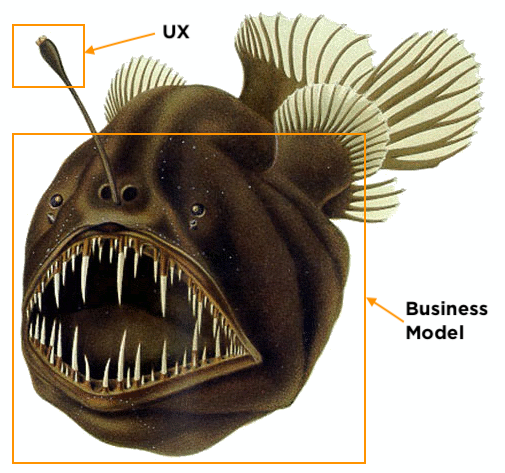
This should not be a surprise. We know that often the user is the product, but many of us have absorbed that cynically into the equation of UX work. Sometimes it’s confusing though. Hurst doesn’t mention that you can have a great user experience in one sense and be exploited, or exploit others, at the same time (e.g. Uber, Facebook or even heroin). Maybe we shrug now and then, saying “I’m just the designer” and it’s not our jobs to define the business or defend its ethics. Or that working for a questionable company, given our personal situation, is the only option that we have (like the lonely male anglerfish). For many reasons it’s easy to feel like we’re attached to a larger creature, hanging on, along for the ride.
One mistake we make is thinking this is specifically about UX. It’s not. Advertising, marketing, branding and even engineering are more likely to be the lure, as entire apps and services can be the free temptation hovering above a darker business model. It’s far more a diagram about predatory businesses than anything else.
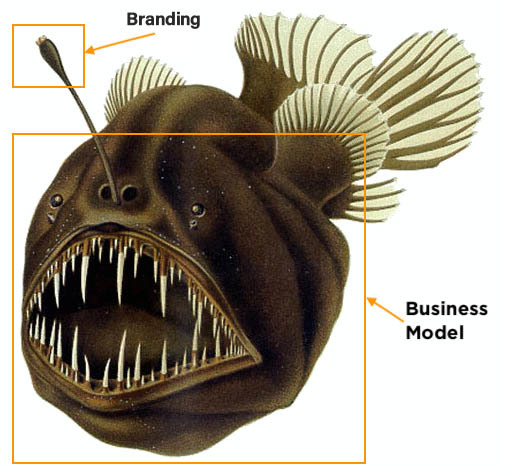
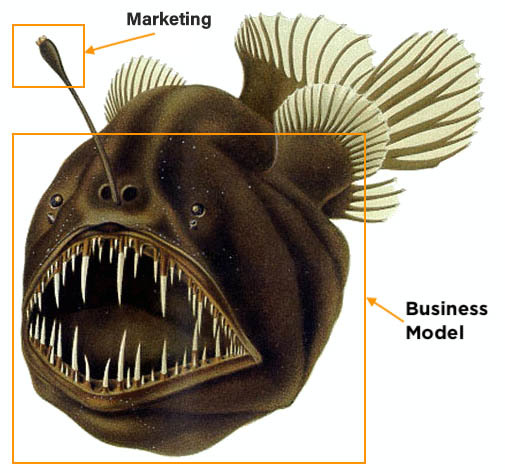
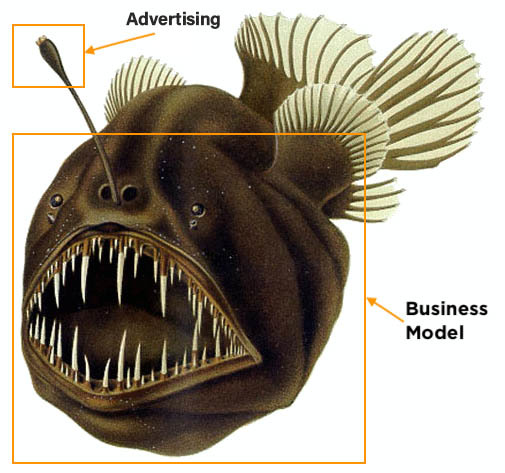
Somewhere in Hurst’s story, and in the design community, was the latent hope that UX was going to reform capitalism. Or be immune from it. That sounds ridiculous, but there is no other explanation for our surprised outrage that these businesses do what they have always done, but now use UX as part of their tactics. As if we are so special and our knowledge beyond appropriation.
I don’t think Hurst’s lost faith is actually in UX. User Experience design is primarily a set of skills. You can’t lose faith in UX any more than you can lose faith in carpentry. Instead he has lost his faith in the willingness of predatory (big tech) corporations to do the right thing. Placing faith there was the mistake, given what we know of the species. To believe most corporations, given their history, would, without regulations and against the wishes of their stockholders, invest in good design and ethical practices above other considerations is about as foolish as hoping anglerfish will go vegetarian. Even the billionaires who choose to do good do their philanthropy through foundations, not corporations.
This is depressing and I’m sorry. It’s not entirely your fault that we’re in this situation. Design culture has always been self-aggrandizing. Something rarely mentioned in design schools or books is the possibility that good design may have little impact on why some businesses succeed or not. There is a reason why Norman doors, for all of their usability flaws, are still popular in the world. We laugh at them, and countless other obvious “unusable” designs of confusing microwave ovens, tech gadgets or the latest trending social media app, but the joke is on us. We think we are seeing incompetence, but instead it’s evidence there are successful businesses where our services aren’t important and we’d prefer to stay in denial.
Hurst overlooks that Amazon customers are happy even with bad UX. It is one of the top five most loved and respected brands in the United States, despite the design and ethical issues he rallies against. Google, a common target of distain from UX experts, is among them too. The truth about Amazon customers is they care more about cheap prices, two-day delivery and a great return policy than anything UX designers are likely to improve. In the places where this isn’t true, perhaps Alexa or Kindle or their next new service, they likely will invest more in design. Currently Amazon’s strongest revenue growth is in AWS and it’s possible their consumer businesses won’t be as important in the future. There’s a logic here, we just don’t like it.
Should customers have different priorities? Including concerns about how poorly Amazon employees, and suppliers, are treated to achieve those low prices? Should citizens demand corporations do less damage to society? I say yes, but my opinion is irrelevant to Amazon. And Walmart. And the stock market. And it’s irrelevant in a way to all of us who want the growth stocks in our mutual funds and 401ks to rise, while we rarely ask what the real cost of that growth might be.
Returning to the anglerfish, for no particular reason at all, certainly not for any metaphoric relevance to where I’m headed, there’s another fascinating fact about its biology. Females accept multiple male sexual partners. And when each male latches on, it slowly loses organs it no longer needs. It loses its eyes and its fins, its kidneys, even its precious heart gets reabsorbed into its new host. It is no longer a creature itself. It is just a sexual appendage. It hangs on, sensing its fellow men but unable to see them, surviving day after day with no purpose and no function, except to provide parasitic underwater sex on demand.

For a typical business, UX design is seen as a specialization. Businesses have many specialized roles they hire for. They fit into a larger strategy for profit and growth decided by people who are in generalized roles. Even if you work on a large team, under a Director of UX, many of the important design decisions you have to work with are likely not made by designers. The budgets, schedules, and requirements come from people who know far less about making great/ethical products than you or your team does, in part because making great products isn’t their goal. Unless someone influences their thinking, that is the way it will stay.
Your faith in UX, as promised in the title of this essay, comes in an unexpected form and it starts here. You must trust that you are good at UX design and that your focus, for a time, must go elsewhere. If most of the big design decisions are made by people who you think are bad at design, or are unethical, you need to broaden what you think design is. The VP, the PM, the engineer, if they’re making decisions that “should be yours” or are “terrible”, then they’re designers too and powerful ones. This means there are only three reasonable choices:
Move into a role where you make the important decisions.Become better at influencing decision makers.Find a place to work that has higher standards (or start your own).Unfortunately the most common choice might be #4: complain and/or do nothing. It’s human nature to prefer the familiar, even if disappointing, to the unknown. It’s a safe choice because many make it. It’s less scary than the alternatives and it’s often immediately rewarded as others will complain with you. They may also tell you #1 is a betrayal. That you won’t be a “designer” anymore, despite how if you do it you’ll be making the decisions you felt you should have been yours all along (as well as paving the way for the next “designer” to have more power). For #2, some will say “Why should I have to?” and the answer is you don’t. You don’t have to do anything. However if you want something to change, participation is required.
The day you were hired you likely knew more about good design than most of your organization, including the executives. Put your faith in your UX knowledge and use it as a foundation to stand on, instead of a weight holding you down. Ignore the standard design books, design conferences and design media for a time. Don’t keep sharpening the sharpest tool you have if it’s clearly not the one you need.
Instead learn about how consultants persuade. Studying business for designers is good, but even better is to immerse yourself in a founder or product management community. Study their arguments and their theories on their turf. Ask questions. Learn to speak their language, so you can be a better translator. Maybe you can do it locally, if there’s someone on “the other side” in your org you get along with well. Ask them to mentor you. Make them an ally. Treat the powerful people you want to influence as if they were your users: you want to study them, charm them, so they can be users of your ideas.
It can seem insurmountable that one individual could ever gain much influence. If the host creature, or organization, is large and powerful, what hope could there ever be to redesign how things work? This is how we must imagine the sad male anglerfish feels as he rides along, playing the same small role for all time. But what he can’t know, that you can, are other stories. What he can’t do, that you can, is make new choices. You are free to change your relationship to your organization, to your work and to yourself.
Consider, for example, the abilities of the emerald wasp. It’s a fraction of the size of the creature it needs to influence (a roach). It’s so small it’s not seen as a threat. It’s underestimated, but it has studied well and perfected its skills. Once it finds the right place and time, in an instant it strikes and lets the design of its persuasive chemistry do the work. Soon it has control of the mind of what once was its superior, pulling it gently along, without even a struggle, to do its bidding. Now imagine if our emerald coated friend wasn’t working alone, but had allies with a shared mission? What might be achievable then? In nature, and design, anything is possible.

(Note: American corporations should be better regulated to act more as members of society, and penalized for profiting from behavior that damages the greater good, but this is a systemic issue beyond the scope of design which is why I didn’t address it directly in this essay. I’ve received constructive feedback on this omission and wanted to address it in some fashion. Added 2-6-2021).
Scott Berkun is the author of How Design Makes The World. You can read a related thread on #designethics on twitter.
Thanks to Bryan Zug and Phillip Hunter for draft feedback.
How To Put Faith in UX Design
Anglerfish are famous for the glowing lure they dangle from their heads that they use to catch small fish. But this is not the most interesting thing about them. Their most fascinating trait is how they mate. Males of the species, who are much smaller, lack a functioning digestive system. To survive they must combine, or fuse-mate, with the females. This means they bite into the female’s skin, releasing an enzyme that bonds them together for life. In exchange for the nutrients they need to live, they provide her with sperm. If this sounds desperate that’s because it is: only 1% of males live long enough to find a mate.

If the equivalent of the shiny lure atop the anglerfish were part of a tech product, deceiving people into making bad choices, we’d call it a dark pattern: a deliberate deception that causes harm to one party but benefits the other. But we don’t use this label to apply to nature because… well I’m not sure why. Evolution is about good design for survival and we can learn from its history, even if we don’t agree with its morality. But the history of design most UX designers know starts with the Macintosh. We have a narrow view of how design fits into the world, even into the world of business, and that works against us.
Corporations, like anglerfish and other living things, are designed to survive. They evolve and use tactics that manipulate perception. Consider how the tail of a male peacock is a kind of advertising. Or how that ultraviolet light in orchid petals, crafted to attract insects for fertilization, is part of its “plant marketing strategy.” There’s perhaps nothing wrong with trying to get others interested in what you have to offer. It seems fair and natural, doesn’t it?
Yet there is also the Cuckoo bird. It lays an egg in other bird species’ nests without the mother knowing. When the young cuckoo hatches, it pushes its unhatched step-siblings out of the nest to fall to their death. It’s a killer baby bird! We’d call this immoral, or homicidal, if humans did it, but we struggle to rationalize our morality with the natural world we’ve evolved from and are still a part of.
Founders, as a kind of creature to stay with the metaphor, don’t start companies to “make great user experiences.” Instead their goals, as explained to investors, are to generate profits, growth and value for shareholders. How society, the environment, customers and employees fare is often secondary. They may make things that improve our quality of life, but they are not generally altruistic. They hire people to help with their stated goals, and not for any other reason.
Remember that we had to shame automobile companies for years to put in seat belts. We had to fight for decades to get the makers of cigarettes to admit they were unhealthy. These were among the most profitable industries of their eras, and Big Tech has parallels to Big Auto and Big Tobacco. We might want a better designed world for everyone, but the literal design of corporations, the nature of their species so to speak, makes them creatures with more selfish ambitions.
In Mark Hurst’s recent essay, Why I’m losing faith In UX, he explains how he sees a decline in the last 30 years of User Experience design. He calls out how Amazon Prime’s cancellation process is now 6 pages long. And how leaders of Facebook, Google, Amazon, and Apple have lied under oath about the harm of their products. He calls out how ” design thinking” as popularized by Stanford’s d.school has empowered Silicon Valley to exploit people. He offers that in Big Tech the meaning of UX has changed from user experience to user exploitation. There’s merit to what Hurst is saying, but he’s missing the larger picture of the animal he is grappling with.
Hurst references Erika Hall’s popular tweet that offers a diagram (shown below) about the relationship: “This is all too often how UX design is considered and practiced.” I think she’s saying that while some designers do good work on the (small) things they control, they contribute to a negative net impact on the people they are designing for, given the dubious ethics of the underlying business that pays them (actually the meme implies customers will be eaten alive! But smarter predatory businesses want you to be a zombie, who buys things in ads and has good cash flow).

This should not be a surprise. We know that often the user is the product, but many of us have absorbed that cynically into the equation of UX work. Sometimes it’s confusing though. Hurst doesn’t mention that you can have a great user experience in one sense and be exploited, or exploit others, at the same time (e.g. Uber, Facebook or even heroin). Maybe we shrug now and then, saying “I’m just the designer” and it’s not our jobs to define the business or defend its ethics. Or that working for a questionable company, given our personal situation, is the only option that we have (like the lonely male anglerfish). For many reasons it’s easy to feel like we’re attached to a larger creature, hanging on, along for the ride.
One mistake we make is thinking this is specifically about UX. It’s not. Advertising, marketing, branding and even engineering are more likely to be the lure, as entire apps and services can be the free temptation hovering above a darker business model. It’s far more a diagram about predatory businesses than anything else.



Somewhere in Hurst’s story, and the design community, was the latent hope that UX was going to reform capitalism. Or be immune from it. That sounds ridiculous, but there is no other explanation for our surprised outrage that these businesses do what they have always done, but now use UX as part of their tactics. As if we are so special and our knowledge beyond appropriation.
I don’t think Hurst’s lost faith is actually in UX. User Experience design is primarily a set of skills. You can’t lose faith in UX any more than you can lose faith in carpentry. Instead he has lost his faith in the willingness of predatory (big tech) corporations to do the right thing. Placing faith there was the mistake, given what we know of the species. To believe most corporations, given their history, would, without regulations and against the wishes of their stockholders, invest in good design and ethical practices above other considerations is about as foolish as hoping anglerfish will go vegetarian. Even the billionaires who choose to do good do their philanthropy through foundations, not corporations.
This is depressing and I’m sorry. It’s not entirely your fault that we’re in this situation. Design culture has always been self-aggrandizing. Something rarely mentioned in design schools or books is the possibility that good design may have little impact on why some businesses succeed or not. There is a reason why Norman doors, for all of their usability flaws, are still popular in the world. We laugh at them, and countless other obvious “unusable” designs of confusing microwave ovens, tech gadgets or the latest trending social media app, but the joke is on us. We think we are seeing incompetence, but instead it’s evidence there are successful businesses where our services aren’t important and we’d prefer to stay in denial.
Hurst overlooks that Amazon customers are happy even with bad UX. It is one of the top five most loved and respected brands in the United States, despite the design and ethical issues he rallies against. Google, a common target of destain from UX experts, is among them too. The truth about Amazon customers is they care more about cheap prices, two-day delivery and a great return policy than anything UX designers are likely to improve. In the places where this isn’t true, perhaps Alexa or Kindle or their next new service, they likely will invest more in design. Currently Amazon’s strongest revenue growth is in AWS and it’s possible their consumer businesses won’t be as important in the future. There’s a logic here, we just don’t like it.
Should customers have different priorities? Including concerns about how poorly Amazon employees, and suppliers, are treated to achieve those low prices? Should citizens demand corporations do less damage to society? I say yes, but my opinion is irrelevant to Amazon. And Walmart. And the stock market. And it’s irrelevant in a way to all of us who want the growth stocks in our mutual funds and 401ks to rise, while we rarely ask what the real cost of that growth might be.
Returning to the anglerfish, for no particular reason at all, certainly not for any metaphoric relevance to where I’m headed, there’s another fascinating fact about its biology. Females accept multiple male sexual partners. And when each male latches on, it slowly loses organs it no longer needs. It loses its eyes and its fins, its kidneys, even its precious heart gets reabsorbed into its new host. It is no longer a creature itself. It is just a sexual appendage. It hangs on, sensing its fellow men but unable to see them, surviving day after day with no purpose and no function, except to provide parasitic underwater sex on demand.

For a typical business, UX design is seen as a specialization. Businesses have many specialized roles they hire for. They fit into a larger strategy for profit and growth decided by people who are in generalized roles. Even if you work on a large team, under a Director of UX, many of the important design decisions you have to work with are likely not made by designers. The budgets, schedules, and requirements come from people who know far less about making great/ethical products than you or your team does, in part because making great products isn’t their goal. Unless someone influences their thinking, that is the way it will stay.
Your faith in UX, as promised in the title of this essay, comes in an unexpected form and it starts here. You must trust that you are good at UX design and that your focus, for a time, must go elsewhere. If most of the big design decisions are made by people who you think are bad at design, or are unethical, you need to broaden what you think design is. The VP, the PM, the engineer, if they’re making decisions that “should be yours” or are “terrible”, then they’re designers too and powerful ones. This means there are only three reasonable choices:
Move into a role where you make the important decisions.Become better at influencing decision makers.Find a place to work that has higher standards (or start your own).Unfortunately the most common choice might be #4: complain and/or do nothing. It’s human nature to prefer the familiar, even if disappointing, to the unknown. It’s a safe choice because many make it. It’s less scary than the alternatives and it’s often immediately rewarded as others will complain with you. They may also tell you #1 is a betrayal. That you won’t be a “designer” anymore, despite how if you do it you’ll be making the decisions you felt you should have been yours all along (as well as paving the way for the next “designer” to have more power). For #2, some will say “Why should I have to?” and the answer is you don’t. You don’t have to do anything. However if you want something to change, participation is required.
The day you were hired you knew likely knew more about good design than most of your organization, including the executives. Put your faith in your UX knowledge and use it as a foundation to stand on, instead of a weight holding you down. Ignore the standard design books, design conferences and design media for a time. Don’t keep sharpening the sharpest tool you have if it’s clearly not the one you need.
Instead learn about how consultants persuade. Studying business for designers is good, but even better is to immerse yourself in a founder or product management community. Study their arguments and their theories on their turf. Ask questions. Learn to speak their language, so you can be a better translator. Maybe you can do it locally, if there’s someone on “the other side” in your org you get along with well. Ask them to mentor you. Make them an ally. Treat the powerful people you want to influence as if they were your users: you want to study them, charm them, so they can be users of your ideas.
It can seem insurmountable that one individual could ever gain much influence. If the host creature, or organization, is large and powerful, what hope could there ever be to redesign how things work? This is how we must imagine the sad male anglerfish feels as he rides along, playing the same small role for all time. But what he can’t know, that you can, are other stories. What he can’t do, that you can, is make new choices. You are free to change your relationship to your organization, to your work and to yourself.
Consider, for example, the abilities of the emerald wasp. It’s a fraction of the size of the creature it needs to influence (a roach). It’s so small it’s not seen as a threat. It’s underestimated, but it has studied well and perfected its skills. Once it finds the right place and time, in an instant it strikes and lets the design of its persuasive chemistry do the work. Soon it has control of the mind of what once was its superior, pulling it gently along, without even a struggle, to do its bidding. Now imagine if our emerald coated friend wasn’t working alone, but had allies with a shared mission? What might be achievable then? In nature, and design, anything is possible.

Scott Berkun is the author of How Design Makes The World.
Thanks to Bryan Zug and Phillip Hunter for draft feedback.
January 28, 2021
Do you teach with my book? Get in touch for a custom video
Over the years it’s been rewarding to see how many courses use one of my books. I write to teach and it’s great to know I can help teachers do what they do.
If you’re someone who uses one of my books in a class, you should get in touch.
Three reasons:
Now and then there are bonus materials I produce for my books (like this Speaking Checklist for Confessions of a Public Speaker). If I know you use my book, I can notify you when this happens.I can make a short video for your class or appear remotely to answer questions. It’s fun, it helps me learn and often gives me ideas for new things to write about. I’d like to thank you! I appreciate what you do and honored you’re using something I made.For example: here’s a recent video I made for Dr. Lisa Gundry at DePaul University for her course on Innovation. A quick lesson on how design and innovation go together, but it’s trickier than it seems.
November 25, 2020
My answers to the Proust Questionnaire: What Are Yours?
They say the web is decaying all the time and it’s true. When sites redesign they break hundreds or thousands of previously working links. I discovered this fun interview from 2008 by Sara Peyton at O’Reilly Media had disappeared.
I recovered it thanks to the Web archive and reposted it here. It’s based on the Proust questionnaire, a parlor game by the eponymous author. You should give it a try.
12 years is a long time and I need to reconsider my answers to some of these questions, but for now I’ll stand with them as they are.
————————————
Scott Berkun Answers Proust’s Questions
By Sara Peyton, June 2008
Having proven his range as a writer, speaker, and now on CNBC’s The Business of Innovation TV show, O’Reilly’s bestselling author Scott Berkun ponders happiness, friends, and other concerns in the O’Reilly Proust Questionnaire.
What is your idea of perfect happiness?
An evening spent drunk as a loon, looking up at stars, sitting by a bonfire, laughing with friends.
What is your greatest fear?
Waiting to die with a mind full of regrets.
On what occasion do you lie?
This is the first lie I’ve ever told.
What is your favorite journey?
Wherever I’m going next that I haven’t been to before.
Which living person do you most despise?
It’s a tie between Bill O’Reilly and Dick Cheney.
Which words or phrases do you most overuse?
My friends would say its mother*****r. But I don’t think this word can be overused.
Which talent would you most like to have?
Mind-reading is hard to beat, but I’d settle for time-travel.
If you could change one thing about yourself, what would it be?
The willingness to let myself make more mistakes.
If you could change one thing about your family, what would it be?
Open their eyes.
If you were to die and come back as a person or thing, what would it be?
If a thing, the most perfect object in NYC: The Chrysler Building. Or maybe Central Park (is it cheating to call that one thing? I like to cheat). If a person, I’d like to be me again.
What do your consider your greatest achievement?
Writing every day. Ok, that’s a lie. I don’t write every day. But just trying to write every day is hard enough.
What is your most treasured possession?
My mind. I dont care much for material things. Besides, you never have to worry about someone breaking into your mansion and stealing your mind, you know? It’s the only thing than will always be only yours.
What do you regard as the lowest depth of misery?
Watching someone innocent suffer for your own carelessness.
What is the quality you most like in a man?
Integrity.
What is the quality you most admire in a woman?
Curves.
What do you most value in your friends?
Brutal honesty, dark comedy, and trust under fire.
Who are your favorite writers?
George Orwell, Henry Miller, George Saunders, Raymond Carver, Bertrand Russell, Peter Drucker, Loren Eisley, John Gardner, Ray Bradbury, Hubert Selby Jr.
Who is your favorite hero of fiction?
How can you top Don Quixote? There’s no way.
Who are your heroes in real life?
Don Quixote isn’t real? Are you sure?
How would you like to die?
Drunk as a loon, looking up at stars, sitting by a bonfire, laughing with friends.
What is your motto?
Be amazed by everything.
November 24, 2020
Sale Today: 50% off paperback edition of How Design Makes The World
You can now get my latest book, How Design Makes The World, for 50% of the paperback price here in the U.S. It’s just $9.99 on Amazon in the U.S.
This deal will last through Friday. The book makes a great gift for anyone curious about design, or who you wish understood how good design actually happens. It’s full of great stories and written for just about anyone.
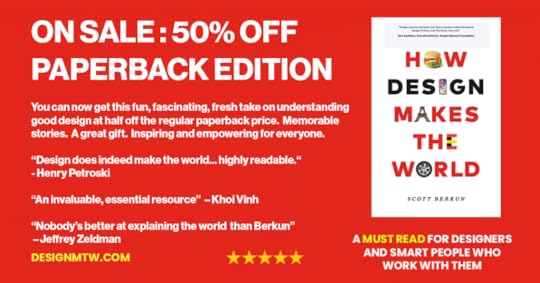
October 21, 2020
Audiobooks are finally here
It’s taken quite a few years but the audiobook versions for three of my most popular books have finally been released.
I gave them a listen and they’ve been well produced by Tantor Audio. They’re available through Amazon or Audible through the links below, including free samples:
Making Things Happen
Myths of Innovation
Confessions of a Public Speaker

September 16, 2020
Lessons from the Xerox-914: the first copy machine
A great innovation in business tech was announced on Sept. 16th in 1959 – The Xerox 914. It is one of the great breakthroughs in office technology and product design.
It was the first copy machine that resembles the ones we know and the inventions inside it led to the laser printers we use today. It’s hallmark was simplicity: unlike it’s complex competitors, you simply placed your paper on glass and pressed a button. How Chester Carlson invented it is a great story of risk and persistence and a better one to learn from than most.
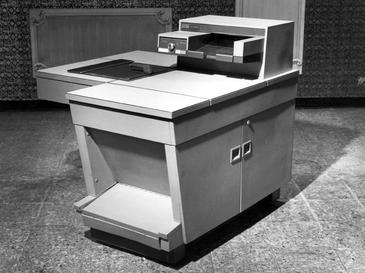
Carlson worked at Bell Labs in the 1930s in the patent department. He had 100s of ideas for different inventions, but focused on copying because typing with carbon paper was messy and frustrating (You had to place a sheet of the carbon paper between two sheets of regular paper, and writing or typing would be copied to the second sheet). His patent department made hundreds of copies and he found the process frustrating. The “cc:” line in email applications today is a reference to the manual process of making a carbon copy,.
Carlson was fired in 1933 (Great Depression). By 1936 he had a new job and went to night school to study law. Too poor to buy books, he had to hand copy them from the library! Copying was his nemesis. To relax he read books on science, and there he learned about Pál Selényi’s work on electrostatic images and he saw a way for his idea to become real.
He did chemical experiments in his own home, to the annoyance of his family and neighbors. He made unavoidably smelly compounds, melting sulfur (!) over zinc plates in the kitchen smelling like rotten eggs, once even starting a fire. By 1938 his wife told him he had to do his work elsewhere..
Using Selényi’s ideas (roughly: use light to remove static charge, not create it) and his own, after many experiments he had a ‘breakthrough’ in 1938. But unlike the myth of epiphany, he realized that moment depended on many others:
“Things don’t come to mind readily, all of a sudden, like pulling things out of the air”
This is the first xerox copy in history.
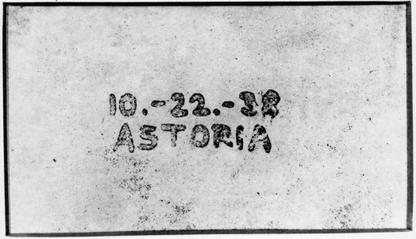
He soon had a patent but more rough times were ahead. Between 1939 and 1944 he was turned down by 20 companies, including IBM and the U.S. Navy.
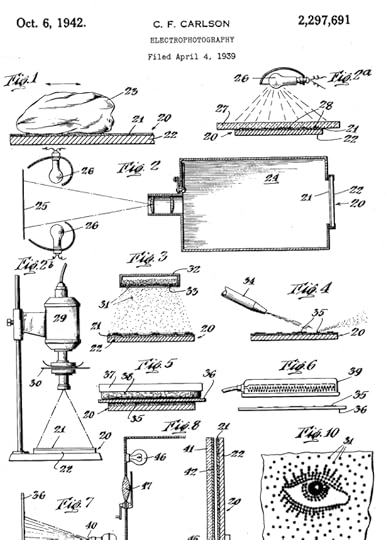
He and his wife Elsa von Mallon soon divorced. He described the marriage as “an unhappy period interspersed with sporadic escapes.” Perhaps those kitchen fires and terrible smells made him a hard man to live with.
Carlson continued to work in patents at the P. R. Mallory Company. One day he was able to demo his work to an engineer from Battelle, who was only there his employer’s office to testify for a patent case. Battelle never took in outside ideas but were impressed and offered financial support. It only took 20 YEARS, but he finally had support for his idea.
In 1946 they signed a deal with Haloid (later to be renamed Xerox), a competitor to Kodak. In 1948 they released the Xerox Model A Copier. It took 39 steps to make a single copy.

Another decade of development led to the Xerox 914 – named because it could copy paper up to 9″ x 14″. This model become popular quickly because it:
was simple to usedidn’t damage originalscould be rented used regular paperIt took almost 30 years but Carlson’s dream was finally real. At the push of a button you could make a perfect copy.

As innovative as it was, as with most new tech it had some problems.
It tended to overheat (one demo model caught on fire on launch day), often enough that it came with a “scorch eliminator” – a sales friendly term for fire extinguisher. Ralph Nader’s machine caught fire 3 times in 4 months and he complained to the press about it.
Even so, they had great sucecss marketing it on ease of use – including a TV ad where a young girl, Debbie, makes copies.
A follow up ad used a chimpanzee, but led to harassment for secretaries and was rarely used.
Compared to today it’s true these machines were:
largehard to maintainfragileunreliable, as paper jams (‘mispuff’) happened oftenThe machines often required a small team of people who maintained them and managed taking in copy requests and delivering them (the copy room). But relative to competitors it was a breakthrough in many ways and these issues were improved over time.
The story of Xerox and Carlson is a great example to learn from – it doesn’t suffer from any of the Myths of Innovation. The time from having an idea to making it a real product in the marketplace took decades, which is more often the case than most people realize.
His patents made him wealthy enough to retire. He gave most of his fortune away, anonymously, including support for Buddhism, NYCLU and the NAACP. He died in 1968.
References:
en.wikipedia.org/wiki/Chester_C…
amazon.com/Copies-Seconds…
cosmosmagazine.com/technology/sci…
en.wikipedia.org/wiki/Battelle_…
books.google.com/books?id=ZYurh…
Lessons from the Xerox-914: the first real copy machine
A great innovation in business tech was announced on Sept. 16th in 1959 – The Xerox 914. It is one of the great breakthroughs in office technology and product design.
It was the first copy machine that resembles the ones we know and the inventions inside it led to the laser printers we use today. It’s hallmark was simplicity: unlike it’s complex competitors, you simply placed your paper on glass and pressed a button. How Chester Carlson invented it is a great story of risk and persistence and a better one to learn from than most.

Carlson worked at Bell Labs in the 1930s in the patent department. He had 100s of ideas for different inventions, but focused on copying because typing with carbon paper was messy and frustrating (You had to place a sheet of the carbon paper between two sheets of regular paper, and writing or typing would be copied to the second sheet). His patent department made hundreds of copies and he found the process frustrating. The “cc:” line in email applications today is a reference to the manual process of making a carbon copy,.
Carlson was fired in 1933 (Great Depression). By 1936 he had a new job and went to night school to study law. Too poor to buy books, he had to hand copy them from the library! Copying was his nemesis. To relax he read books on science, and there he learned about Pál Selényi’s work on electrostatic images and he saw a way for his idea to become real.
He did chemical experiments in his own home, to the annoyance of his family and neighbors. He made unavoidably smelly compounds, melting sulfur (!) over zinc plates in the kitchen smelling like rotten eggs, once even starting a fire. By 1938 his wife told him he had to do his work elsewhere..
Using Selényi’s ideas (roughly: use light to remove static charge, not create it) and his own, after many experiments he had a ‘breakthrough’ in 1938. But unlike the myth of epiphany, he realized that moment depended on many others:
“Things don’t come to mind readily, all of a sudden, like pulling things out of the air”
This is the first xerox copy in history.

He soon had a patent but more rough times were ahead. Between 1939 and 1944 he was turned down by 20 companies, including IBM and the U.S. Navy.

He and his wife Elsa von Mallon soon divorced. He described the marriage as “an unhappy period interspersed with sporadic escapes.” Perhaps those kitchen fires and terrible smells made him a hard man to live with.
Carlson continued to work in patents at the P. R. Mallory Company. One day he was able to demo his work to an engineer from Battelle, who was only there his employer’s office to testify for a patent case. Battelle never took in outside ideas but were impressed and offered financial support. It only took 20 YEARS, but he finally had support for his idea.
In 1946 they signed a deal with Haloid (later to be renamed Xerox), a competitor to Kodak. In 1948 they released the Xerox Model A Copier. It took 39 steps to make a single copy.

Another decade of development led to the Xerox 914 – named because it could copy paper up to 9″ x 14″. This model become popular quickly because it:
was simple to use
didn’t damage originals
could be rented
used regular paper
It took almost 30 years but Carlson’s dream was finally real. At the push of a button you could make a perfect copy.

As innovative as it was, as with most new tech it had some problems.
It tended to overheat (one demo model caught on fire on launch day), often enough that it came with a “scorch eliminator” – a sales friendly term for fire extinguisher. Ralph Nader’s machine caught fire 3 times in 4 months and he complained to the press about it.
Even so, they had great sucecss marketing it on ease of use – including a TV ad where a young girl, Debbie, makes copies.
A follow up ad used a chimpanzee, but led to harassment for secretaries and was rarely used.
Compared to today it’s true these machines were:
large
hard to maintain
fragile
unreliable, as paper jams (‘mispuff’) happened often
The machines often required a small team of people who maintained them and managed taking in copy requests and delivering them (the copy room). But relative to competitors it was a breakthrough in many ways and these issues were improved over time.
The story of Xerox and Carlson is a great example to learn from – it doesn’t suffer from any of the Myths of Innovation. The time from having an idea to making it a real product in the marketplace took decades, which is more often the case than most people realize.
His patents made him wealthy enough to retire. He gave most of his fortune away, anonymously, including support for Buddhism, NYCLU and the NAACP. He died in 1968.
References:
en.wikipedia.org/wiki/Chester_C…
amazon.com/Copies-Seconds…
cosmosmagazine.com/technology/sci…
en.wikipedia.org/wiki/Battelle_…
books.google.com/books?id=ZYurh…



